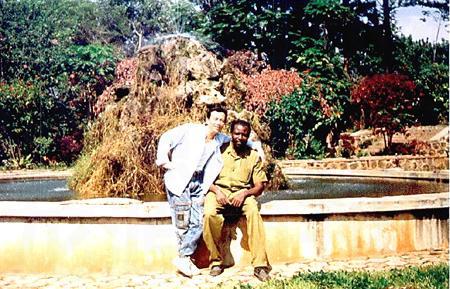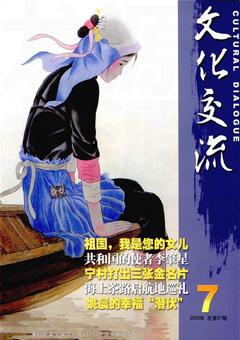A Village Wedding in Rwanda
By Tang Lichun


A village wedding I attended during my stay in Rwanda is vivid in my memory. Kayas is a local girl I know. In October she invites me to attend her sister Kasias wedding. I am curious about local peoples lifestyle. Kayas jumps with joy when I say yes.
Early Sunday morning, I wrap some gift money with a piece of red paper in the Chinese tradition and attach a brief congratulatory message written in Kinyarwanda, a local language widely used in Rwanda. Kayas waits me at the gate. On the way to the village, she explains in words of Kinyarwanda, Chinese and French languages that local people are extremely friendly and hospitable. I am cautioned that local people have an open attitude toward sex and I should relax and not get offended. I gesticulate that I am a Chinese and I will have great hospitality.
We walk for more than an hour before we see the village. The village is happiness itself. Children rush to us and eye me curiously. I distribute candies and they shout happily, “China! Ni Hao!” It seems that everyone in the region is able to say this Chinese hello.
Followed by the kids, we arrive at the house. Standing in front of the house, Kayas wears a cap made of red and white shawls, an alabaster long-sleeved dress and a very long skirt in bright colors. She smiles brightly. I make a bow and present the gift money. Kayas reads the congratulatory message aloud. All the people chant China! China! They give me thumbs up.
I am chosen as a representative of the brides family. Kayas and I walk with Kasia to the church. The bridegroom waits us at the steps leading up to the church. He is very surprised to see me. He wears a French cap, a very bright-colored necktie a round-neck shirt and a black suit, a pair of yellow pants with its bottoms rolled high up and a very fancy pair of leather shoes. He does not wear socks. Someone whispers something to him. His face lights up and he utters a high-note happy cry. The bride and the bridegroom walk with me in the center into the church as if I were the bridegroom.
I put the hands of the bride and the bridegroom together and then withdraw to a bench in the front row. A priest begins a long ceremony and reads his bless.
The newlyweds bow to a statue of St. Maria and the crowd begins to sing loudly. Then the people troupe out of the church. The bride and the bridegroom stay on an earth platform and the people dance around the platform in the accompaniment of a drum.
The villagers drink home-made fruit wine. Some distinguished people drink beer. Beef and mutton, boiled in salt water first and then deep-fried, are a very popular food in Rwanda. Villagers eat beef and mutton with their fingers. Kayas made a pair of chopsticks for me. They are not chopsticks. They are just two thick sticks. Some curious villagers come close and want to see how I use the chopsticks. I decide to use my fingers too.
The banquet ends after 4 oclock in the afternoon. I decide to go back to the factory. Kayas asks me to stay. I am supposed to go with her family and escort the bride to the home of the bridegroom. The bridegroom lives in a village not far away.
Villagers here eye me most curiously. I become the most important guest. The new house for the newlyweds is made of walls of sugarcanes plastered with red soil. Two fires are in front of the house. On the ground in front of the door of the house is a red line. Kayas explains that the bridegroom is to put himself over the first fire and the bride, led by someone of the brides family, is to walk the back on the bridegroom to cross the fire. This ceremony indicates that the husband has respect for the wife and that the husband is willing to sacrifice for the wife. The representative of the brides family is then to carry the bride and step over the fire and hand the bride to the bridegroom. This ceremony is designed to express the wifes love of the husband. The task of the brides family is to hand the bride over to the most trustworthy man (the bridegroom) before the people of the brides family can go back home.
I am chosen by the brides family to walk across the back of the bridegroom over the first fire and carry the bride over the second fire and take the bride across the red line. I try to say no in vain.
The bridegroom takes off his fancy suit and shirt and get down over the fire. I lead the bride walk across. The bridegroom then gets up and jumps over the second fire. He stands in front of the door and gesture me to carry the bride over. I take off the shoes and carrying the bride in my arms. I jump forward and land beyond the red line. The crowd cheers.
The walls of the wedding chamber are whitewashed. There is a portrait of the president of Rwanda in the central wall. On one side of the room are four wood stumps, symbolizing a bed. On the ground inside the invisible line defined by the stumps are sugarcane leaves. On the leaves is a mattress. On the mattress is a fine wool blanket whose trade mark suggests it is made in England. Over the bed is a mosquito net made in China. On the left side of the door stand another four wood stumps, topped by wood cases covered by plastic paper. The room is bright in candlelight.
Then I am given a difficult task: I should take out a strip of cloth from the lower abdomen of the bride and then put it on the bed. I shake my head. The village head says that I am given the honor because I am a guest and I am a Chinese.
The bride stays in the room while the bridegroom withdraws to the door and all the other people also withdraw to the door. I am extremely nervous. The bride opens her skirts and I saw a narrow red strip of cloth goes to the private parts. A thin string goes around the waist and fastens the red cloth. I blush. I stretch my hand toward her belly but I dare not look at her. She grabs my hand and put it on the cloth. I pull it out in a hurry.
All are quiet as if they stopped breathing. They look at me. I am utterly at loss about where I should place the cloth. I dont think I should put it on the sugarcane leaves. The wood stumps are not right either. Then I decide to put it on a bamboo pole which hangs the mosquito net.
The crowd suddenly burst into loud cheers. It is so loud and so sudden that I start. Some young men rush to me and carry me outside and throw me up into the air and chant China! Great! China! Great! Kayas explains to me in words and gestures that the cloth is regarded as symbol for the woman and her future. If you think she is a bad woman, you throw the cloth to the ground or out of the house. If she is a good woman, you place it on the bed or on the stumps. If you think a woman is noble and great, you put it on the mosquito net, giving the highest honor and glory to that woman. The bridegroom hugs me and shakes me excitedly, muttering something in gratitude. The bride weeps beside him.
I leave the village after 6 oclock. All the villagers see me off. Eight young men escort me all the way to where I stay.□

